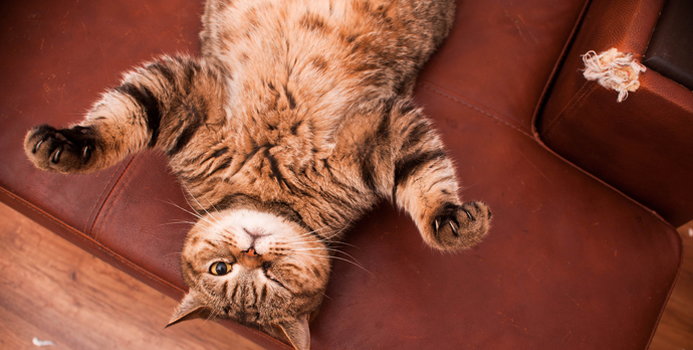Believe it or not, pets can be a main source of dirt and germs in your home — even if it's at a microscopic level. That’s why keeping a careful eye on your cat, disinfecting your living space frequently, and regular vet visits are musts.
1. Germs
Pets, including cats, track in a variety of germs that can make you sick. A study conducted by the National Sanitation Foundation (NSF) found that pet 9 percent of pet bowls tested contained E. coli, 18 percent had coliform bacteria (which can indicate fecal/poop contamination), 14 percent tested positive for staph aureus, and 45 percent contained yeast and mold. Pet toys were also tested for contamination; 14 percent contained coliform bacteria, 24 percent had staph aureus, and 57 percent of pet toys tested contained yeast and mold.
2. Poop and Pee
Unless you have an outside cat, your pet is likely peeing and pooping in a litter box and touching fecal material with their paws. So it’s not uncommon for pee and poop (in small amounts) to get tracked throughout your floor after each cat’s trip to the litter box.
3. Rabies
Many viruses that infect cats aren’t transmitted to humans, but rabies can indeed be passed from cats to humans. Cats “track” in rabies if they’ve been bitten by an infected animal — and rabies attacks the central nervous system (which is very dangerous). Rabies vaccinations help prevent your cat (and you) from being infected, but if you’ve been bitten by an animal it’s time to check in with your doctor.
4. Fleas and Ticks
Outside cats are especially susceptible to bringing fleas and ticks into your home. There are some diseases (such as cat-scratch disease) that can be transmitted from cats to humans via fleas and ticks, so it’s important to rid your home (and cat) of these tiny creatures as soon as possible.
5. Ringworm
When your cat tracks in ringworm, a skin infection caused by fungi, you’re at risk for getting it too. Cornell University says that in humans ringworm appears as red, itchy or round lesions with rings around the edges. If you cat does contract ringworm treatments are available, but be sure to clean and disinfect your house to reduce the risk of transmission.
6. Roundworms and Hookworms
Cats may bring parasites into your home as well. Beware of roundworms and hookworms, as these parasites can cause diseases in people as well as cats. Treatments are available for cats infected with parasites, but in the meantime avoid touching cat’s poop to keep yourself parasite-free.
7. Dirt and Litter
Of course, if you have indoor cats you probably have litter tracked all over your floors, at least the floor near litter boxes. Cats track in dirt and mud too, so beware of this when allowing outside cats inside.
Keeping Your Home Clean
Clean and disinfect your home regularly to avoid catching what your cat tracks in. Keep an eye out for fleas, ticks, and parasites in your cat’s poop — and attend regular vet visits with all pets.
[Image via Shutterstock]



